DIY glass greenhouse: materials and design features
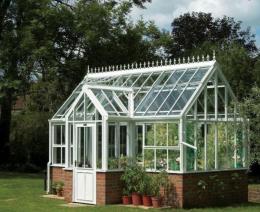
Natural and weather conditions do not always make it possible to grow a decent harvest. Hail, rain, sudden cold snaps, all this can negatively affect the quality of the harvest. A greenhouse made from glass with your own hands can help with this.
Content:
- Which is better: a greenhouse made of glass or polycarbonate
- Where to start building a glass greenhouse with your own hands: choosing a location
- Laying the foundation and making the frame
- How to fix glass in a greenhouse
- Homemade double-glazed greenhouse and its advantages
- Features of the design of a winter glass greenhouse
Which is better: a greenhouse made of glass or polycarbonate
Buildings made of glass were very popular a few decades ago.
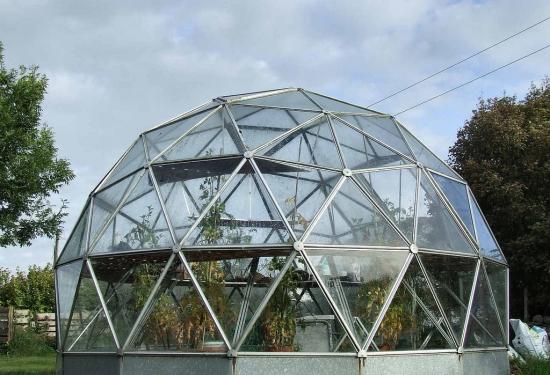
However now, it is increasingly being replaced by polycarbonate the main advantages of which include:
- The ability to transmit ultraviolet radiation without harm to plants;
- Flexibility - polycarbonate can be easily bent and given the desired shape without harm. Therefore, it is much easier to assemble a greenhouse from it, especially if the material is of high quality;
- Easy to handle - if necessary, polycarbonate layers can be easily replaced with new ones, without the danger of damaging other parts;
- Heat retention - in early spring, polycarbonate buildings warm up much faster than glass ones, which is especially important for those who decide to grow greens.However, it is important to remember that it is not suitable for hot summer days, as there is a danger of simply burning the seedlings;
- Resistant to large masses of snow - it does not crack or leak at the joints, which allows you to not fear the destruction of the greenhouse during prolonged winter snowfalls.
Some gardeners consider polycarbonate to be an ideal material, but others note a number of disadvantages, which include too dim light and the danger of burning plants when the temperature outside rises.
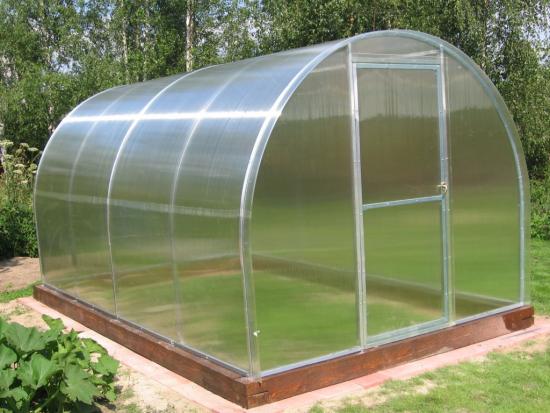
At the same time, the advantages of glass are noted:
- Durability - glass on average lasts up to fifty years without losing its presentation. At the same time, polycarbonate loses its transparency after a few years and needs to be replaced;
- Protection from fungi, mold and harmful microbacteria, which is ensured by a continuous structure, in contrast to the honeycomb structure of polycarbonate, due to the unimportant insulation of the edges;
- Insensitive to temperature fluctuations, does not deform;
- Low cost - during construction it is not necessary to use new glass; what has already been used will do;
- Non-fire hazardous - does not melt due to increased temperature and does not catch fire, unlike polycarbonate. The latter, although it is difficult to ignite, easily loses its shape with increasing temperature;
- It is harder, does not bend and retains its original shape;
- Practicality in relation to heating systems. When glazing, you can use absolutely any kind, since it is not as sensitive to temperature increases as plastic. This also makes it possible to install a “warm floor” in a solid glass greenhouse;
- It transmits light perfectly, as it is much more transparent than polycarbonate and does not retain it.
You can argue about the advantages and disadvantages of materials for a long time, but it is important to remember that during construction you can also pay attention to a third option for solving the problem.
Combine both by covering the roof with polycarbonate, which will reduce the load of snow mass and the glass sides. This option is much more convenient and cheaper than completely covering the frame with plastic.
When choosing, it is important to focus on the quality of the material, weather conditions, and take into account what exactly will be grown. Only by answering these questions can you choose the most suitable option.
Where to start building a glass greenhouse with your own hands: choosing a location
After the issues with materials have been resolved, it is recommended to devote at least as much time to choosing a place where to locate the building. Correct location is the key to a large and healthy harvest.
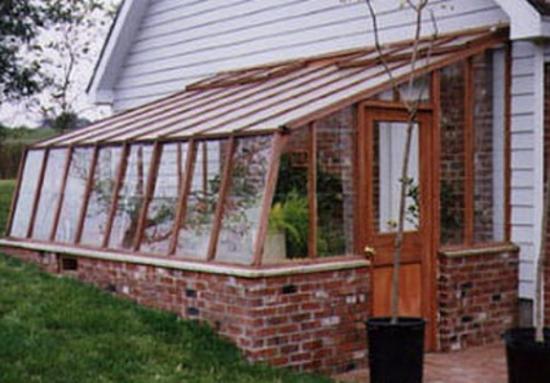
So, when choosing a place, it is important to consider whether it will be convenient to approach it, compare its future location with the wind rose, position in relation to sunlight, and determine how convenient it will be to conduct electricity to it.
Other aspects to consider include:
- The proximity of trees is especially important, since broken branches can pierce the material of the roof and walls and destroy the crop;
- How large the angle of inclination of the area under the structure is, it is recommended to take this into account in order to reduce unnecessary loads;
- Is the site located in a place where snow mass rolls off the main building in winter or water flows during summer and off-season rainfalls;
- Wouldn't it turn out that the building would be like a wind tunnel formed by the walls of buildings?
Selecting the right location for a future structure is an important stage of construction.It is the correct choice that determines how good the harvest will be and how much effort will have to be spent on caring for the structure and maintaining it in working condition.
Laying the foundation and making the frame
The second stage, which is no less important than the choice of location, is laying the foundation. It is important to take into account that a glass greenhouse is quite heavy in weight and its pressure on the foundation is important to take into account.
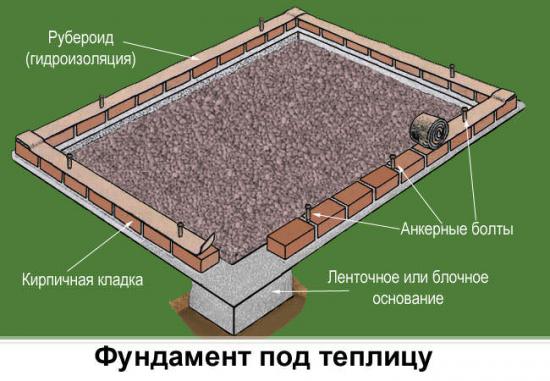
In addition, when choosing a specific type of foundation, it is recommended to pay special attention to the soil, since how stable the structure will be depends on them.
There are several types of foundations that are most suitable for such a structure.:
- Monolithic slab - suitable for the construction of large greenhouses located on clay soils;
- Monolithic tape, represented by bricks, blocks or solid concrete. Used on non-heaving soils with low soil water levels;
- Piles made of wood, metal, plastic or concrete - used for construction on clay soils that are not prone to rapid absorption of precipitation;
- Pillars made of concrete, brick or blocks are recommended for buildings on hard, stable soils of light structures.

The choice of frame options for future construction is no less varied. The most common ones are those listed in the table.
| House | It is distinguished by the presence of straight side walls, the glazing of which is carried out right down to the ground, which creates the most comfortable conditions for seedlings. In addition, this type of construction can easily withstand the loads of snow and rain, minimizing the risk of glass damage. |
| Round | It is distinguished by a round shape and a convex or pointed roof.In the center there is a space for the gardener to work. The special design of the transoms ensures high-quality ventilation that does not allow air to stagnate. The only drawback is that it is quite difficult to build such a frame yourself. |
| Dutch | Outwardly, it looks a bit like a “house” type, but the walls in it are located at a slight slope |
| Wall-mounted | It is distinguished by the fact that one of the walls is adjacent to the main building, due to which heat is better retained inside the greenhouse |
The optimal type of frame is considered to be a “house”, which is easy to build. Since the structure consists of flat components, inserting glass is not difficult.
How to fix glass in a greenhouse
After installing the frame, it’s time to think about how to fix the glass in it. Typically one of the following methods is used:
- Traditional - each piece of glass is placed on a special putty and then secured with small pins. Since the modern construction industry is constantly evolving, you can forget about window putty and pay attention to sealing, quickly hardening putties;
- Putty-free is a more modern and higher quality method of fixing glass. With it, the layers are simply inserted into special grooves with a cross-section, which allows sealing without the use of putties.
Both methods are widely used and in choosing it is recommended to focus only on your own convenience and preferences.
Learn more about building a greenhouse with your own hands in the video:
Homemade double-glazed greenhouse and its advantages
Since ordinary window glass is now being replaced by double-glazed windows, it is not surprising that in garden plots you can see greenhouses made of the same material. Since prices for building materials are constantly rising, not only new ones are used, but also used ones that were used in glazing windows.
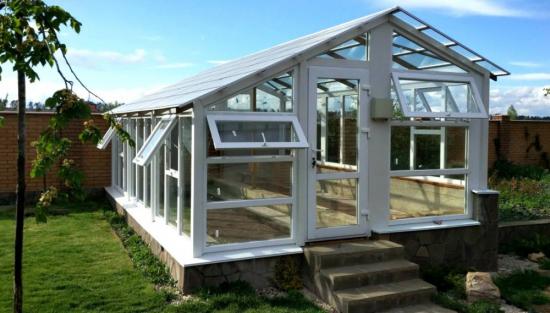
The main advantages of building from double-glazed windows include:
- Neat and attractive appearance;
- Ability to maintain the desired level of humidity;
- High level of resistance to snow weight and wind blows;
- Durability - double-glazed windows do not deform and do not lose transparency for a long time;
- High-quality thermal insulation of the internal space;
- Fire resistance - the components are not flammable;
- Ease of repair of components;
- Easy to care for;
- Resistance to physical stress and shock; if such material is accidentally touched, it will not crack or break;
- Resistance to temperature fluctuations;
- Environmental cleanliness;
- They are an unsuitable environment for the proliferation of fungi and pathogenic microorganisms that could harm plants.
Double-glazed windows are highly durable, which is especially important for any structure. Unlike other materials, they are quite difficult to break even if desired.
Such a structure will serve faithfully for decades and, with proper care, will allow you to reap many harvests.
The only drawback of such a structure is its cost. Purchasing all the materials can put a pretty big dent in your wallet. You can save a little by making the roof from a different material; polycarbonate is perfect for this.
Features of the design of a winter glass greenhouse
Despite the fact that all greenhouses seem exactly the same in their essence and operating principle, this is not entirely true.
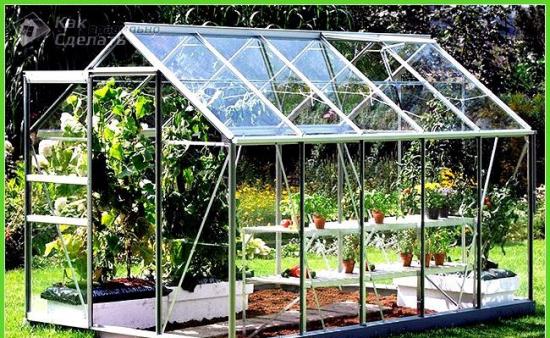
It is important to remember that winter structures have their own characteristics, which should not be forgotten during construction:
- Material - a winter greenhouse will maintain sufficiently high temperatures only if its walls and roof are made of glass. When covering the frame with polycarbonate, stable high temperatures can only be maintained by installing a powerful heating system. And, of course, it cannot be covered with film; this option is only suitable for summer structures;
- It is mandatory to have a heating system, without which plants simply will not grow;
- The basis of the frame - it is recommended to pay special attention to iron and wood, since other materials may not withstand the weight of glass and snow and will simply collapse;
- The shape of the roof - since there is a risk of large amounts of snow falling in winter, it is important to ensure that it is sloped so that it rolls off. If this is not done, the snow mass can push through the roof and fall on the crop;
- The foundation must be solid concrete or brick; in no case should the winter version be installed simply on the ground, without installing a foundation;
- Electricity - since the day at this time of year is significantly shorter than the night, the plants do not receive the required amount of light and it is recommended to support them with additional artificial lighting.
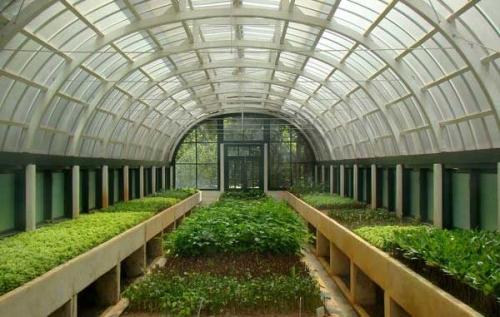
Winter ones have a number of features that should not be forgotten. If you do not pay attention to them, there is a danger of wasting energy and ruining the harvest.
It is quite possible to make a glass greenhouse with your own hands.This will require some effort and money, but if desired, every owner of the plot will be able to develop a greenhouse project and make it a reality.
Another option for low-cost greenhouse construction, watch the video:

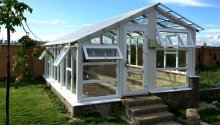
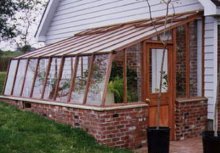
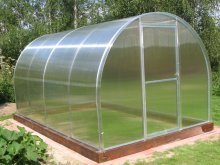
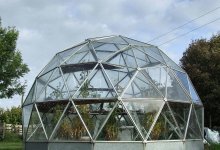
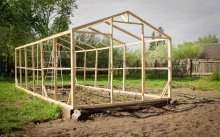

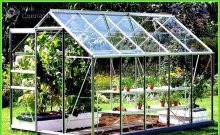
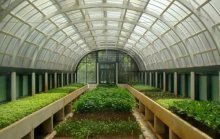
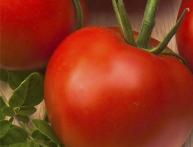

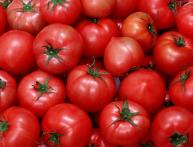
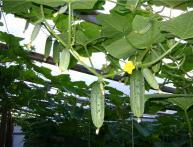
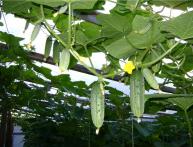
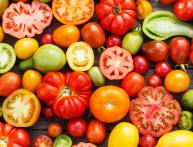
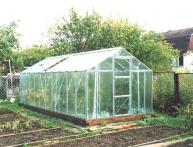
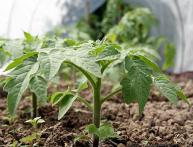
Comments
It also seems to me that glass is better than polycarbonate, it’s not as hot under it as under polycarbonate. Our greenhouse is very small, but made of glass; our neighbors have polycarbonate, and I have already noted that theirs is worse.
Polycarbonate greenhouses are not bad, you just need to ensure that the plants are well ventilated, and for this you need to make 2 doors. And it’s not cheap to buy polycarbonate (to avoid an unpleasant smell), choose thick, durable sheets.
Our greenhouse is made of window frames that my father bought from people after replacing the windows with a plastic version. The result is an excellent greenhouse - warm, the sun does not damage the plants, and now it will last for a long time. Glass is the best material for a greenhouse.